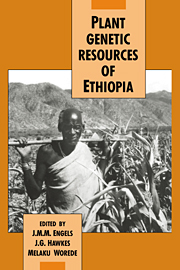Book contents
- Frontmatter
- Contents
- Contributors
- List of acronyms
- Preface
- Part I General introduction
- Part II The Ethiopian centre of diversity
- Part III Germplasm collection and conservation in Ethiopia
- Part IV Evaluation and utilization of Ethiopian genetic resources
- 18 Germplasm evaluation with special reference to the role of taxonomy in genebanks
- 19 Crop germplasm multiplication, characterization, evaluation and utilization at PGRC/E
- 20 Evaluation methods and utilization of germplasm of annual crop species
- 21 Evaluation and utilization of Ethiopian forage species
- 22 Improvement of indigenous durum wheat landraces in Ethiopia
- 23 Use of germplasm resources in breeding wheat for disease resistance
- 24 Indigenous barley germplasm in the Ethiopian breeding programme
- 25 The role of Ethiopian sorghum germplasm resources in the national breeding programme
- 26 Germplasm evaluation and breeding work on teff (Eragrostis tef) in Ethiopia
- 27 Pulse crops of Ethiopia: genetic resources and their utilization
- 28 Oil crop germplasm: a vital resource for the plant breeder
- 29 Significance of Ethiopian coffee genetic resources to coffee improvement
- 30 Use of Ethiopian germplasm in national and international programmes
- Index
19 - Crop germplasm multiplication, characterization, evaluation and utilization at PGRC/E
Published online by Cambridge University Press: 30 October 2009
- Frontmatter
- Contents
- Contributors
- List of acronyms
- Preface
- Part I General introduction
- Part II The Ethiopian centre of diversity
- Part III Germplasm collection and conservation in Ethiopia
- Part IV Evaluation and utilization of Ethiopian genetic resources
- 18 Germplasm evaluation with special reference to the role of taxonomy in genebanks
- 19 Crop germplasm multiplication, characterization, evaluation and utilization at PGRC/E
- 20 Evaluation methods and utilization of germplasm of annual crop species
- 21 Evaluation and utilization of Ethiopian forage species
- 22 Improvement of indigenous durum wheat landraces in Ethiopia
- 23 Use of germplasm resources in breeding wheat for disease resistance
- 24 Indigenous barley germplasm in the Ethiopian breeding programme
- 25 The role of Ethiopian sorghum germplasm resources in the national breeding programme
- 26 Germplasm evaluation and breeding work on teff (Eragrostis tef) in Ethiopia
- 27 Pulse crops of Ethiopia: genetic resources and their utilization
- 28 Oil crop germplasm: a vital resource for the plant breeder
- 29 Significance of Ethiopian coffee genetic resources to coffee improvement
- 30 Use of Ethiopian germplasm in national and international programmes
- Index
Summary
Introduction
The majority of the germplasm accessions maintained by the Plant Genetic Resources Centre/Ethiopia (PGRC/E) are landraces which have evolved under local conditions in the farmers' fields since time immemorial. Such gene pools are the reservoirs of variation which provide the raw material for crop improvement. Samples in the form of seeds or whole plants, representing the spectrum of genetic variation within cultivated species and their wild relatives, are currently being collected and maintained in seedbanks and field genebanks throughout the world (Frankel & Hawkes, 1975; Williams, 1984). Of fundamental importance in the management of these resources is the determination of the variation they represent. To this end, characterization of the various crop germplasm collections is undertaken by the multiplication, characterization and evaluation division of PGRC/E in close collaboration with the plant breeders.
In the past, characterization activities were limited in scope and greater attention was given to collection and conservation activities. During the last three or four years, however, the priorities have changed and now include the extension and intensification of characterization and evaluation work, as well as support for the utilization of germplasm. Highest priority has been given to the major economic crops (e.g. cereals, pulses and oil crops) with the aim of providing useful materials for the breeding programmes.
Crop germplasm multiplication and rejuvenation
Because of the earlier priorities, a systematic increase of the collected germplasm accessions did not start until 1982.
- Type
- Chapter
- Information
- Plant Genetic Resources of Ethiopia , pp. 258 - 267Publisher: Cambridge University PressPrint publication year: 1991



